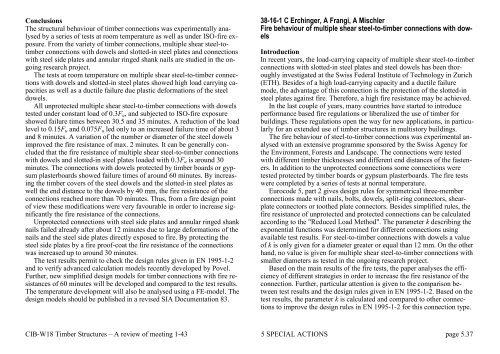CONTENT 5.1 SEISMIC BEHAVIOUR ... - CIB-W18
CONTENT 5.1 SEISMIC BEHAVIOUR ... - CIB-W18
CONTENT 5.1 SEISMIC BEHAVIOUR ... - CIB-W18
You also want an ePaper? Increase the reach of your titles
YUMPU automatically turns print PDFs into web optimized ePapers that Google loves.
Conclusions<br />
The structural behaviour of timber connections was experimentally analysed<br />
by a series of tests at room temperature as well as under ISO-fire exposure.<br />
From the variety of timber connections, multiple shear steel-totimber<br />
connections with dowels and slotted-in steel plates and connections<br />
with steel side plates and annular ringed shank nails are studied in the ongoing<br />
research project.<br />
The tests at room temperature on multiple shear steel-to-timber connections<br />
with dowels and slotted-in steel plates showed high load carrying capacities<br />
as well as a ductile failure due plastic deformations of the steel<br />
dowels.<br />
All unprotected multiple shear steel-to-timber connections with dowels<br />
tested under constant load of 0.3Fu, and subjected to ISO-fire exposure<br />
showed failure times between 30.5 and 35 minutes. A reduction of the load<br />
level to 0.15Fu and 0.075Fu led only to an increased failure time of about 3<br />
and 8 minutes. A variation of the number or diameter of the steel dowels<br />
improved the fire resistance of max. 2 minutes. It can be generally concluded<br />
that the fire resistance of multiple shear steel-to-timber connections<br />
with dowels and slotted-in steel plates loaded with 0.3Fu is around 30<br />
minutes. The connections with dowels protected by timber boards or gypsum<br />
plasterboards showed failure times of around 60 minutes. By increasing<br />
the timber covers of the steel dowels and the slotted-in steel plates as<br />
well the end distance to the dowels by 40 mm, the fire resistance of the<br />
connections reached more than 70 minutes. Thus, from a fire design point<br />
of view these modifications were very favourable in order to increase significantly<br />
the fire resistance of the connections.<br />
Unprotected connections with steel side plates and annular ringed shank<br />
nails failed already after about 12 minutes due to large deformations of the<br />
nails and the steel side plates directly exposed to fire. By protecting the<br />
steel side plates by a fire proof-coat the fire resistance of the connections<br />
was increased up to around 30 minutes.<br />
The test results permit to check the design rules given in EN 1995-1-2<br />
and to verify advanced calculation models recently developed by Povel.<br />
Further, new simplified design models for timber connections with fire resistances<br />
of 60 minutes will be developed and compared to the test results.<br />
The temperature development will also be analysed using a FE-model. The<br />
design models should be published in a revised SIA Documentation 83.<br />
38-16-1 C Erchinger, A Frangi, A Mischler<br />
Fire behaviour of multiple shear steel-to-timber connections with dowels<br />
Introduction<br />
In recent years, the load-carrying capacity of multiple shear steel-to-timber<br />
connections with slotted-in steel plates and steel dowels has been thoroughly<br />
investigated at the Swiss Federal Institute of Technology in Zurich<br />
(ETH). Besides of a high load-carrying capacity and a ductile failure<br />
mode, the advantage of this connection is the protection of the slotted-in<br />
steel plates against fire. Therefore, a high fire resistance may be achieved.<br />
In the last couple of years, many countries have started to introduce<br />
performance based fire regulations or liberalized the use of timber for<br />
buildings. These regulations open the way for new applications, in particularly<br />
for an extended use of timber structures in multistory buildings.<br />
The fire behaviour of steel-to-timber connections was experimental analysed<br />
with an extensive programme sponsored by the Swiss Agency for<br />
the Environment, Forests and Landscape. The connections were tested<br />
with different timber thicknesses and different end distances of the fasteners.<br />
In addition to the unprotected connections some connections were<br />
tested protected by timber boards or gypsum plasterboards. The fire tests<br />
were completed by a series of tests at normal temperature.<br />
Eurocode 5, part 2 gives design rules for symmetrical three-member<br />
connections made with nails, bolts, dowels, split-ring connectors, shearplate<br />
connectors or toothed plate connectors. Besides simplified rules, the<br />
fire resistance of unprotected and protected connections can be calculated<br />
according to the "Reduced Load Method". The parameter k describing the<br />
exponential functions was determined for different connections using<br />
available test results. For steel-to-timber connections with dowels a value<br />
of k is only given for a diameter greater or equal than 12 mm. On the other<br />
hand, no value is given for multiple shear steel-to-timber connections with<br />
smaller diameters as tested in the ongoing research project.<br />
Based on the main results of the fire tests, the paper analyses the efficiency<br />
of different strategies in order to increase the fire resistance of the<br />
connection. Further, particular attention is given to the comparison between<br />
test results and the design rules given in EN 1995-1-2. Based on the<br />
test results, the parameter k is calculated and compared to other connections<br />
to improve the design rules in EN 1995-1-2 for this connection type.<br />
<strong>CIB</strong>-<strong>W18</strong> Timber Structures – A review of meeting 1-43 5 SPECIAL ACTIONS page 5.37














